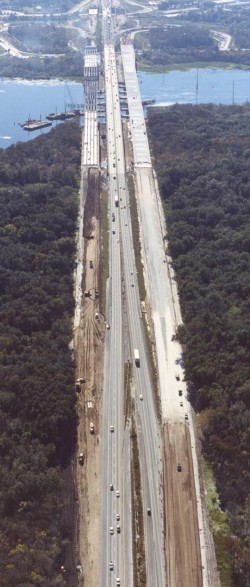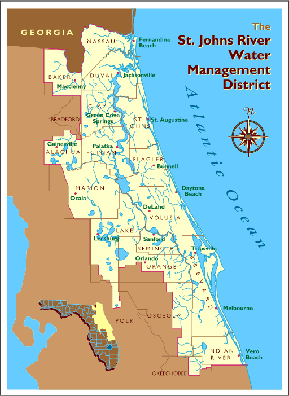|
|
Canku Ota |
|
|
(Many Paths) |
||
|
An Online Newsletter Celebrating Native America |
||
|
January 25, 2003 - Issue 79 |
||
|
|
||
|
Burial Site Marks
Cultural Effort |
||
|
by Ronald Williamson - Daytona
Beach News Journal
|
||
|
credits: Aerial
Photograph by: Aerial Innovations, Inc. - Photo St Johns River Bridge
- Dec 2, 2002
|
 Trunks
of gray cypress edge the small cove like tall headstones of weathered
granite. A low sun west of Lake Monroe silhouettes long wisps of moss
on branches of bronzed cypress needles. Trunks
of gray cypress edge the small cove like tall headstones of weathered
granite. A low sun west of Lake Monroe silhouettes long wisps of moss
on branches of bronzed cypress needles. It's late December and I'm visiting the unmarked grave of someone I never knew. No one knows its precise location. The general location, however, is known by millions. It's where Interstate 4 crosses the St. Johns River, a sprawling construction site of men and towering cranes building a bigger bridge. Human remains were disturbed three winters ago during an archaeological dig at a 5,000-year-old village midden at the east end of the bridge. Florida law requires an archaeological survey when prehistoric sites may be disturbed, but no one seemed thrilled about finding pieces of human bones in the path of a fast-tracked federal highway project. Not archaeologists, nor state and federal officials, nor American Indians who claimed kinship. Especially the Seminoles. They took it personally. Chief Jerry Haney of the Seminole Nation of Oklahoma sent Ted Underwood here to make sure the ancestral bones were treated with respect. Underwood, 51, is chief of the Miccosuke Band of the western Seminoles. His ancestors were removed from Florida 160 years ago by the U.S. Army. "Our elders tell us that once interred, human remains never should be disturbed," said Underwood. Remains are associated with very strong medicine, and when they're disturbed "it's almost like being around something that could be hazardous." Until the bones rest, the place has bad medicine. While officials decided what to do, the skull fragments were wrapped in plastic, reburied and marked with metal stakes. State and federal officials were notified, as were American Indian tribes with Florida roots. Underwood and other Seminoles met archaeologists and road officials at the Florida Department of Transportation's district offices in DeLand. "It was a problem, the disturbance of these remains," said Ken Hardin, an archaeologist at the meeting. He called the talks emotional, and harrowing, and said they showed that federal and state officials needed a common strategy when remains are disturbed. As a result of the talks, Hardin said, federal and state rules now agree on how to treat disturbed human remains. Florida also hired its first American Indian monitor to ensure the site's protection and preservation. "I consider it a success story," Underwood recalled, "an example of cooperation. Not only did they try to accommodate our beliefs, but they went out of their way to learn about our culture." After the talks, the men who disturbed the bones returned to carry out Seminole wishes, and clear the place of bad medicine. No examinations or tests were made as the bones were unwrapped and returned to the dark midden soil, "the dust from which they came," as the Miccosuke put it. The bones rest far beneath the new bridge's high earthen approaches, an unseen testament to the strength of today's preservation laws. No such protections existed in 1962 when I-4 was built through this early human site. About a fourth of the ancient midden was obliterated when it was excavated to fill wetlands for the highway. It seems likely that the eternal rest of many humans was seriously disturbed by that, and no effort was made to put those bones to rest. The old borrow pit lies just south of the highway. It's a pretty little cove edged by tall gray cypress, and filled with amber lake water and lots of bad medicine. Williamson is an editor at the News-Journal's West Volusia office and can be contacted by e-mail at ronald.williamson@news-jrnl.com.
|
|
|
||
|
|
||
| Canku Ota is a free Newsletter celebrating Native America, its traditions and accomplishments . We do not provide subscriber or visitor names to anyone. Some articles presented in Canku Ota may contain copyright material. We have received appropriate permissions for republishing any articles. Material appearing here is distributed without profit or monetary gain to those who have expressed an interest. This is in accordance with Title 17 U.S.C. section 107. | ||
|
Canku Ota is a copyright © 2000, 2001, 2002, 2003 of Vicki Lockard and Paul Barry. |
||
 |
 |
|
|
The "Canku Ota - A Newsletter Celebrating Native America" web site and its design is the |
||
|
Copyright © 1999, 2000, 2001, 2002, 2003 of Paul C. Barry. |
||
|
All Rights Reserved. |
||
 The
St. John River is the longest river wholly in Florida at 310
miles and only drops approximately 30 feet from the headwaters
to the ocean. That is just over 1" per mile with the most
slope in the first 100 miles. The water shed (drainage area)
is 8,840 square miles. The River is unusual in that there is
little slope, the river is wide in the middle but with a narrow
mouth and is one of the few rivers in the US that flows north.
The
St. John River is the longest river wholly in Florida at 310
miles and only drops approximately 30 feet from the headwaters
to the ocean. That is just over 1" per mile with the most
slope in the first 100 miles. The water shed (drainage area)
is 8,840 square miles. The River is unusual in that there is
little slope, the river is wide in the middle but with a narrow
mouth and is one of the few rivers in the US that flows north.